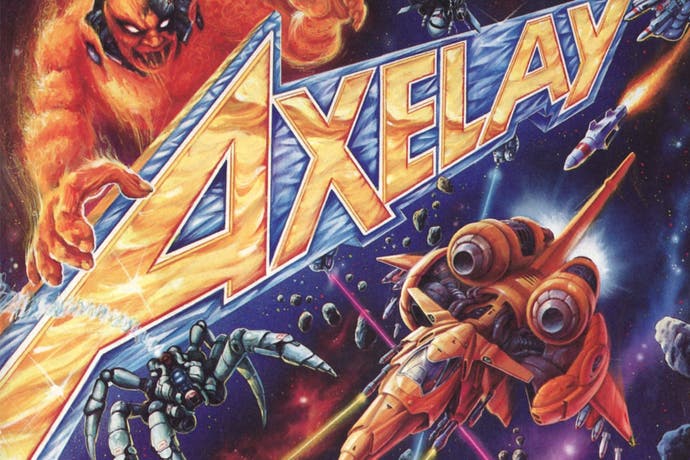Axelay saw Konami at its 90s peak
Axelay rose.
Sega's boot-up logos of the 16-bit era might be the most fondly remembered, but for me it's Konami's that will always be the best. That scan line bringing the black screen to life, climaxing with a twinkling chime reminiscent of an arcade cabinet fed with a new 20 pence piece; it promised so much, and more often than not it would deliver. The early 90s were a golden era for Konami. Viewed through the filter of my own personal tastes, I'd go as far to say it saw the developer at its very best.
On the home front there were boisterous, polished and effortlessly cool games such as Contra 3, Sunset Riders and Super Castlevania 4 - classics that, well over 20 years later, retain their ability to excite. Axelay, which has just been granted a new lease of life on the Wii U's Virtual Console, stands proud amongst that company, but to understand its appeal you've got to go back to the lineage of arcade games to which it owes so much.
Konami's shooters of the 80s and 90s are the stuff of legend, and deservedly so. Amidst the post-Space Invaders gold rush in the arcades, it's the likes of Gradius and Salamander that acquired enduring iconic status, born of their character and their poise. It's something you see, to varying degrees, in the developer's other shooters of the era - in the colour and bounce of Detana!! TwinBee, the drunken exuberance of Parodius Da or the psychedelic excess of Xexex.

They're games that made their way to home consoles via ports of varying quality - with the sad exception of Xexex, which took over 15 years to make it out of arcades in 2007's Salamander Portable compilation - but it's the SNES exclusive Axelay that bundled that strange brand of Konami cool and transposed it away from the din of the arcades with the greatest success.
It's Salamander - itself a curious offshoot of the Gradius series - that Axelay owes most to, with levels that alternate between horizontal and vertical scrolling. There's an interesting divide between the two that can be as frustrating as it is fascinating: Axelay is two very different games sewn together by some brilliant shared systems.
The vertical levels are the ones Axelay's often remembered for, and understandably so. It's where Konami plays to the host hardware, the levels wrapping under the player like a rolodex. It makes for a unique spectacle, shots warping out across the horizon while waves of enemies warp towards you, though it also makes for a slightly unwieldy brand of shooting. Your ship, the titular Axelay, feels somewhat disobedient, having to be tugged this way and that as it roams the vibrant futurescapes. The squat thrusters and bulbous rear end in the ship design play to this peculiar lethargy in control.
Side-scrolling levels restore some of the crispness of control seen in Konami's other shooters, and it's not all they inherit. There are hints of Thunder Cross and Gradius in the ship design that go beyond the oblique to the explicit when the sand dragons of Gradius 3 start slithering across later levels. There was a port of Gradius 3 on SNES, of course, though Nintendo's console never really played home to that many shooters, many of which found a home on the PC Engine or Mega Drive. Axelay works so well because it's one of the few games in the genre built with a particular home console in mind.
That much is evident in the weapon system, a step removed from the coin-op standard where firepower can be gained as quickly as it's stolen away - inviting you to plunder your pockets for small change when your last life is lost. Axelay plays a longer game, its weapons slowly unlocked upon completing each stage, the three slots at your disposal customisable in inter-level screens.

Progression comes at a steadier pace, but it also impacts the fundamentals. Having three weapons at your disposal lends an element of strategy, one that would be picked up the following year by Treasure's Gunstar Heroes, a game developed by a number of Konami alumni. There's something else of Treasure in the way certain weapons act like solutions to the puzzles that enemies present; witness the way the Round Vulcan fires in a smooth arc around you, sifting through the ships that circle you in Axelay's opening moments.
The spectacle and cool is pure early 90s Konami, though, the swagger and strength triumphantly soundtracked by a Taro Kudo score that makes you feel like an absolute hero. That's what shooters do better than any genre, where you're one tiny ship pitted against armadas of evil aliens and impossibly large bosses, where you pick through the flak to deliver that one winning laser shot right into the glowing weak spot. Axelay delivers on that fantasy just as well as any other game of the 16-bit era, and it does so with its own unique sense of style.
There's only one slight disappointment about returning to Axelay after all these years. Complete the game on hard mode - something that, thanks to the save restore system on the Wii U, is much less daunting now - and you're given a cheery farewell. "See you again in Axelay 2", the posts-credit message says - and after two decades we're still waiting for that reunion. Seeing how a limp shooter market has meant even headline names such as Gradius have been left dormant for years, it's unlikely we'll ever see Axelay return, though maybe that's for the best. The 1992 original stands alone, untainted, as the perfect reminder of what once made Konami so very special.

